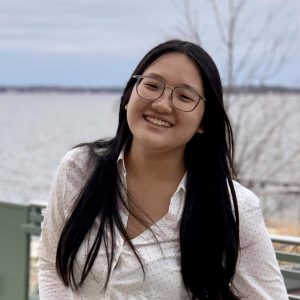Student Historians in Residence – A Conversation
by Abigail Winterburn, Libraries Student Communications Writer
MADISON, Wisc. – Students who attend the University of Wisconsin-Madison strive to acquire more knowledge and skills not offered in a regular class. The University allows students to become a part of different projects that help them achieve their goals. An example of this is the University’s Student Historian Program.
Cat Phan, a Digital and Media Archivist who manages the digital archiving program at UW-Madison, spoke about the purpose of the Student Historian Program.
“The goal of our program is to empower students holding marginalized identities to document their own communities’ histories and experiences on campus. I hope we’re providing a supportive environment and a lot of autonomy to each student to develop a project that speaks to their interests,” said Phan. “In doing so, I hope students enjoy an experience where they get to follow their academic interests and not just intellectual pursuits assigned to them.”
The two Student Oral Historians currently working for UW-Madison are Sydney Tang and Sophia Abrams.
Tang is working on completing her first year as a Student Historian in Residence.

“My project, in general, focuses on students of color who were in the Wisconsin Union Directorate (WUD). My process for starting my project began with creating a list of ideas I think I would be interested in seeing when I reflect on my experiences,” said Tang. “While looking through the archives to see what materials there were regarding the WUD, one recurring thought I had was I wished I could hear the stories and experiences I was reading from the perspective of those involved. Because of this, I found oral history to be a good start.”
Tang completed two oral history interviews. She is now working on her third and is writing content and figuring out what photos, newspapers, and other ephemera to include.
Although she’s still in the process of completing her work, she has made some critical decisions.
“Regarding how I’ll be using the interviews, I imagine an online exhibit or website that highlights the challenges, accomplishments, identity development, and community-building aspects that past WUD students of color faced while being on the programming board,” said Tang. “I want to push my abilities beyond reflections and academic writing, and I feel a website could do that.”
When planning her ideas, Tang received help from her fellow Student Historian in Residence, Sophia Abrams.
“I look up to Sophia, and I am constantly in awe of her work and dedication to her project,” Tang said. “She has helped me a lot in giving me advice on how she conducted an oral history project.”

Sophia Abrams became part of the Student Oral Historian Program in September of 2020. With the pandemic in full swing, Abrams realized she had more time to expand her learning.
“I wanted to explore and research blackness in the arts, and now I’m utilizing oral history to do that,” said Abrams.
Abrams is an Afro-American Studies and Journalism major at UW-Madison. “I found this opportunity to be a great way to tie these two interests together, and I was getting more into art history, so I wanted to tie that in as well,” commented Abrams when asked about why she decided to take on this project.
During her first year, Abrams strictly conducted oral history through interviews. Although she faced some struggles due to COVID, she also found some hidden benefits.
“I interviewed people from all over, so if the pandemic hadn’t happened, I would have picked a more localized project,” she said. “My project is still UW-Madison centric, but I’m also talking to people that graduated from the university 50 years ago and no longer lived in the area. That’s something that’s kind of interesting about my experience.”
So, on what exactly is Sophia Abrams working? Well, her exhibitions’ central thesis and primary mission are to “really create an immersive experience with art, Black art specifically.”
Abrams is not only using her exhibitions to showcase her interviews, research, and art; she also hopes to encourage viewers to learn more on their own.
“Viewers of the exhibitions can follow up and do their digging to keep learning about my research,” said Abrams.
She hopes when people come to see her work, they will feel inspired to dive deeper into her findings and leave with one main takeaway.
“The main takeaway from the exhibitions would be to have people understand the nuances of Black art, the broadness of Black art, and from a deeper level the history of Black art,” said Abrams.
Abrams and Tang continue to further their research and soon will provide the community with two pieces of work to showcase the achievements of being a Student Oral Historian.
“The program very purposely provides this opportunity to undergraduate students who don’t have as many opportunities to engage in individually driven research endeavors,” commented Phan when asked why it’s essential to provide students this opportunity.
Moving forward, Phan has a “dream that the Student Historian program can grow beyond just a couple students per year.”
She hopes soon they can partner with others on campus who can support the students within the program. Until then, Phan is excited to support the Student Historians as they present their work to the community.
Abrams and Tang had the chance to share their work and reflections during a special event on April 19: “A Conversation with the UW Archives Student Historians.” (Online and at College Library at 7:00 p.m.)

